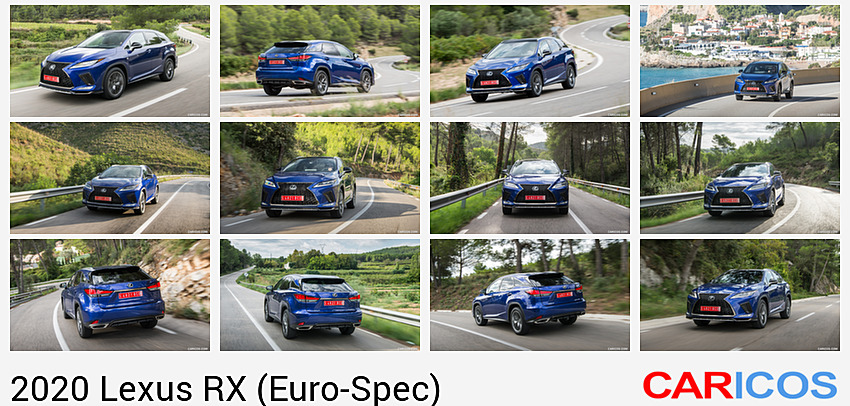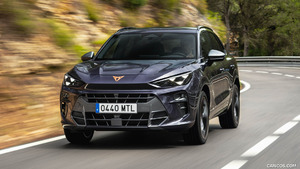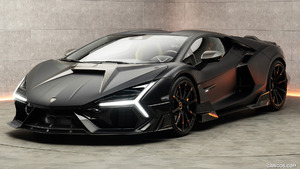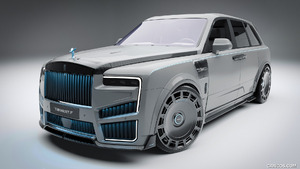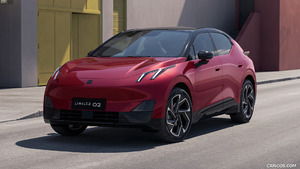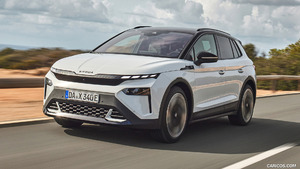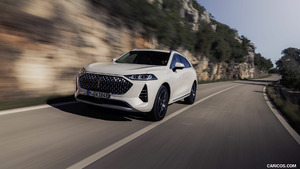2020 Lexus RX (Euro-Spec)
THE PIONEER OF THE LUXURY SUV SEGMENT EVOLVES TO NEW HEIGHTS
The RX is one of the most significant models in Lexus’ 30-year history. The original RX, launched in 1998, was a unique proposition in its day: an SUV that was luxurious, comfortable and easy to drive, in particular in urban environments where conventional SUVs proved unwieldy. It was an instant success and inspired a new and vital market segment in which today almost every premium manufacturer is represented.
Across two decades, Lexus has constantly improved the RX, which quickly became its worldwide best-selling model. Cumulative global sales to date have reached 3 million units. Its importance to the brand is witnessed by the fact it became Lexus’ – and the world’s – first luxury self-charging hybrid vehicle, with the market introduction of the RX 400h in 2005.
The current, fourth generation RX pushed the boundaries of the luxury SUV concept even further on its launch in 2015, as it acquired more emotional design and more engaging driving dynamics, and increased its market appeal with the addition of the seven-seat RX L model in 2018.
The 2020 RX has benefited from further improvements in a series of design, technical and dynamic upgrades that go well beyond the usual level of changes implemented in a product’s mid-lifecycle, in line with Lexus’ determination to exceed customers’ expectations.
Chief Engineer Takeaki Kato said: “In developing the new model I was determined to keep and further refine the ‘one-of-a-kind’ value that only the RX could create, which has been cultivated since the first generation.”
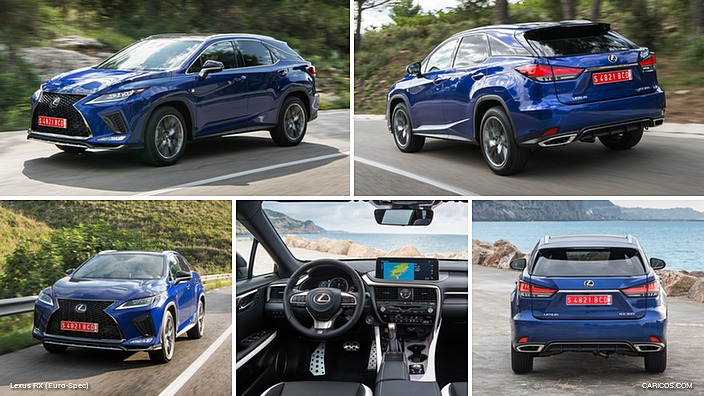 2020 Lexus RX (Euro-Spec)
2020 Lexus RX (Euro-Spec)
The changes he and his team have delivered are led by new, evolutionary styling that maintains the RX’s powerful and sporty appearance, while introducing more elegant elements and creating a coherent flow from front to rear, giving the vehicle a stronger, unified look. Details of the frontal treatment include a new rendition of the signature Lexus grille, with a mesh pattern of radiating “L” shapes that forms a design link to the UX urban crossover; slimmer headlight units; more rounded edges to the front bumper; and an extended line from the rocker panel that connects with the bottom of the grille to project strength and stability. At the rear, a more elegant and powerful look has been created with a redesigned lower bumper that links smoothly to the rear wings. Elements such as the lights, reflectors, underguard and exhaust outlets are arranged on a strong horizontal axis to emphasise the vehicle’s width and sense of purpose, while new LED combination lights feature a series of L motifs for the brake and tail lights and turn indicators.
The human-machine interface in the cabin has been improved with the availability of a new 12.3-inch central display that has a touchscreen function. To accommodate this new feature, the screen has been moved further forward on the centre console, within easy reach of the driver and front passenger. The multimedia functions can also be operated using a new trackpad version of Lexus’ Remote Touch Interface, or with voice control.
The new RX also provides seamless smartphone connectivity via Apple CarPlay and Android Auto. Voice control can also be enabled via smartphones to Apple Siri of the Google Assistant.
The third-row seats of the RX L now feature two different seating positions, being electronically adjustable, they add even more leg space (+95 mm) when the situation demands it. The second-row seats of the RX L have been reconfigured to include Captain Seats, helping to create a spacious and comfortable cabin for rear-seat occupants.
Dynamic improvements have been achieved by giving the new RX a more rigid body, using laser screw welding, additional spot welds and high-strength adhesive at key points around the chassis. The suspension has been improved with a new, stiffer rear anti-roll bar, more rigid hubs and the use of a new Friction Control Device in the shock absorbers to further reduce high-frequency vibrations from small imperfections in the road surface.
The Adaptive Variable Suspension available for the new RX provides almost constantly variable damping control at each wheel. The new RX also gains Active Cornering Assist, which automatically suppresses understeer if the driver steps on the throttle in mid-corner. The electric power steering has been retuned for a more linear steering feel and better line-tracing faithful to the driver’s intentions.
The latest version of Lexus Safety System + provides additional protection to help prevent an accident happening, or lessen the consequence if the vehicle is involved in an impact. The Pre-Collision System’s functionality has been increased, with pedestrian detection by day and night and daytime detection of bicyclists in the car’s path.
In a world-first, the new RX is available with a BladeScanTM Adaptive High-beam System (AHS), which uses a rapidly rotating blade-shaped mirror to direct light from the LED headlamps. It provides finer and deeper automatic forward illumination, making it easier to see pedestrians on the road margins. It also operates with no risk of dazzling drivers of vehicles ahead.
The new RX range will go on sale Europe-wide from October 2019, with introduction dates varying according to market.
DESIGN
The Lexus design team listened to feedback from current RX drivers around the world when developing their ideas for how they could refine the vehicle’s styling and make the new RX a car that would exceed customers’ expectations.
Development and production teams collaborated closely on the project, with the aim of giving the new RX the kind of Brave Design that is central to today’s Lexus models. The design theme was “seductive strength,” expressed in a more captivating exterior and maximising of the interior packaging – a quality that has proved particularly attractive to customers. The challenge to the designer team was to add elegance, but without diminishing the RX’s powerful SUV image.
Particular attention was paid to surface quality, incorporating more rounded, elegant surfaces at the front and rear. Finer details included changes to the shape, size and mesh pattern of the spindle grille, a new, narrow-aperture shape for the headlights and a distinctive new illumination signature for the rear combination lights.
Exterior design
In revising the RX’s exterior design, Lexus focused on the vehicle’s overall form and silhouette, taking into account the balance between the front and rear and aiming to create a powerful, solid look that generates a greater sense of unity from one end of the vehicle to the other. This can be seen in the body line that flows directly from the front bumper to the sides of the doors, while the shape of the rocker panel now extends from below the doors, flowing into the bottom edge of the front grille, generating a powerful and stable appearance.
The front bumper itself has been changed from a straight and sharp form to being slightly rounded. The surface quality appears tauter, while still being in harmony with the overall design. The shape of the underguard has been changed too, so that it wraps around to the sides, emphasising the width and subtle ruggedness of an urban SUV.
The spindle grille is a central design element for all Lexus models and for the new RX a designer was assigned to work solely on this element of the vehicle. It took almost six months to hand-craft a new mesh pattern, comprising thousands of individual lines.
The bottom edge of the spindle grille frame has been raised, changing the frame’s proportions to harmonise with the sides of the vehicle bodywork. The grille features a new L-shaped block mesh that changes in size as it radiates away from the central Lexus emblem. This design was introduced on the new UX urban crossover, and its application on the new RX creates a new unity within Lexus’ SUV line-up.
The new headlight units present a strong and deeper Lexus signature, with even illumination across the entire surface of the daytime running lights. The same compact headlight unit as Lexus’ LC flagship coupe is adopted, with three projector bi-LEDs. In addition, F SPORT and LUXURY grades use the world’s first BladeScan Adaptive High-beam System, a technology breakthrough that provides deeper and more even illumination (details below).
At the side, the continuity between the front overhang and the doors has been accentuated, with the peak of the cross-section running straight along the side of the vehicle, strengthening the dynamic impression.
At the rear, the “seductive strength” theme can be seen in a new character line which runs from the side of the bumper to the lower reflector, shaped to echo the flow of the rear window graphic. The profile of the bumper matches the form that flows rearwards from the quarter panel, creating a sleeker look.
The bottom edge of the rear bumper has been lowered and all the rear design elements have been set on a horizontal axis, including the combination lights, reflectors, exhaust outlets and the underguard, giving a stronger impression of width and more powerful stance.
The combination lights have a new design of four overlapping L motifs. This distinctive pattern is inverted for the sequential turn indicators, which are set parallel to the upper brake/tail lights.
Two new exterior colours, Terrane Khaki and Ice Ecru, are added to the palette. The exterior styling changes are completed by new 20-inch alloy wheels with silver multi-spoke design.
Aerodynamic features
A number of aerodynamic elements are incorporated in the bodywork, which help achieve a 0.33 drag coefficient and also contribute to vehicle stability and low cabin noise levels.
They include:
- A front under spoiler which directs airflow to the underbody, reduces aerodynamic drag and supports driving stability
- Fin-shaped corner sections beneath the headlights which improve airflow along the sides of the vehicle
- Front pillars designed to create less wind noise during high-speed driving
- Aero-stabilising fins on the tail-light covers, which wrap into the rear wings to give extra aerodynamic stability at the rear of the vehicle
- A rear spoiler across the width of the roof/tailgate window, which reduces lift and adds rear downforce
- A diffuser beneath the rear bumper, which smoothly draws airflow from beneath the vehicle, reducing drag and giving extra stability
Interior design
The cabin design strikes a balance between functionality and luxury, finished with refined materials that exude quality construction and craftsmanship. The ambience is spacious yet intimate, with high levels of comfort for driver and passengers.
To accommodate the new human-machine interface, the screen has been moved further forward on the centre console, within easy reach of the driver and front passenger. The middle column has been redesigned for better trackpad version of Lexus’ Remote Touch Interface integration.
The RX’s seats deliver both support and comfort with an ergonomic design and quality detailing that includes a vertical stitching pattern that is both good-looking and durable. The quilting pattern on the front seat seatbacks matches that on the door panel trims.
The driver and front passenger seats are low-set, allowing for excellent headroom. The position of the steering wheel closer to the driver and a lowered angle for the steering column create a more involving driving position.
The new interior colour is available: Ochre.
The F SPORT grade features refined genuine materials in the interior trim, such as premium leather, natural wood, and brushed aluminium. The new interior colours feature Flare Red and Black and White combinations.
New RX L seating option
The new Lexus RX L gives customers the choice of specifying a three-seat second row bench that divides 60:40, or two individual captain’s seats, with manual fold and recline adjustment. The second row also benefits from a slide range extended by an extra 45 mm to 165 mm, providing easier access to the third-row seats.
Third row seats can be moved forward and backward electronically depending on the customer’s needs, providing additional legroom (+95 mm) for people sitting in the third row. The third-row seat adjustment can be operated via a button from second row or the boot.
Dimensions and packaging
The current generation RX was designed with a more spacious interior, particularly for rear seat passengers. By using a new frame construction for the front seats, more legroom was obtained for the rear passengers, adding an extra 20 mm of knee clearance compared to the previous model. And to help front seat occupants find the ideal seat position, the seat height adjustment range was increased by 15 mm.
The RX is both longer and wider than the previous generation model: width grew by 10 mm to 1,895 mm and length by 120 mm to 4,890 mm; the height was unchanged at 1,685 mm.
The extra length crucially saw 50 mm added to the wheelbase (2,790 mm), allowing for a more spacious and comfortable interior to be designed.
Lexus has comfortably accommodated an extra, third row of seats in the RX L model by adding 110 mm to the rear overhang, taking the vehicle’s overall length to 5,000 mm, and by giving the tailgate window a steeper angle to secure generous headroom for the rearmost passengers.
RX F SPORT
The RX F SPORT raises the sporty image to a higher level with a series of special visual and performance features that distinguishes it from other RX grades.
Exterior details include a black finish to the F SPORT exclusive spindle grille mesh and a new mirror black frame that blends into the side of the front bumpers providing a unified profile. The lower spoiler and a satin-chrome front under guard complete the front fascia redesign.
The 20-inch F SPORT wheels have a multi-spoke design and are fitted with 235/55 tyres.
The interior is styled to suit the F SPORT’s character with exclusive details such as highly supportive seats with quilted upholstery, aluminium trim inserts and the choice of a Black, Black with white accents and Flare Red with black accents colour-way. The shift lever and three-spoke steering wheel are also specific to F SPORT, and covered in a tactile perforated leather, and there are drilled, non-slip aluminium sports pedals.
The instrument cluster is different, too, with an eight-inch display dominated by a larger, circular gauge that cleverly combines the functions of a tachometer and speedometer.
POWERTRAINS
The new RX retains the model’s well-proven range of efficient and responsive powertrains:
- The RX 450h equipped with a self-charging hybrid electric powertrain, featuring a highly efficient 3.5-litre direct injection V6 petrol engine
- The RX 300 with a 2.0-litre turbocharged, direct injection four-cylinder petrol engine
- The RX 350 powered by a 3.5-litre direct injection V6 petrol engine, with an eight-speed automatic transmission
- The RX 450h is available across all European markets; the RX 300 is offered in selected markets; and the RX 350 is sold in Russia, Ukraine and Kazakhstan and the Caucasus region.
RX 450h
The RX 450h’s self-charging full hybrid system features a 3.5-litre direct injection V6 petrol engine, with maximum output of 193 kW/262 DIN hp at 6,000 rpm with 335 Nm of torque at 4,600 rpm. The total system output (engine and electric motor combined) amounts to 230 kW/313 DIN hp.
The engine’s combustion chamber design generates a high degree of tumble inside the cylinders, improving combustion performance. According to the WLTP cycle, CO2 emissions start from 172 g/km and fuel consumption goes from 7.6 l/100km to 7.9 l/100km. (Correlated NEDC figures: fuel consumption combined: from 5.8l/100km, CO2 emissions start from 132 g/km)
The powertrain of the 2020 Lexus RX has remained unchanged and the below improvements apply to the 4th generation Lexus RX. The key components and control systems in the Lexus Hybrid Drive System have been improved and re-engineered to deliver class-leading fuel economy, minimal emissions and excellent on-road performance. The front transaxle gained a new water-cooled transmission oil cooler for the electric motor and a pre-loaded differential to improve performance and straight-line stability.
The rear transaxle featured in the E-Four system used by the all-wheel drive version of the RX 450h was redesigned with a three-shaft configuration, creating a more compact unit in which the input shaft can be moved as close as possible to the output shaft. The design also saves weight by using aluminium for the case and cover.
The shape of the intake ports and combustion chambers generates a high degree of tumble inside the cylinders, improving combustion efficiency.
Other updates to the system included a design evolution of the Power Control Unit (PCU), and HV Engine Control Unit (ECU) that delivers better energy efficiency, more driver-friendly operation and more refined performance. A lighter, more efficient electric water pump was introduced and the hybrid battery was repackaged, making it more compact and improving space efficiency. The E-Four electric all-wheel drive system’s control functions were improved to give better response when accelerating through bends.
RX 300
The RX 300 is powered by a turbocharged 2.0-litre four-cylinder engine that delivers superior fuel economy and driving performance, characterised by crisp throttle response and instant torque delivery throughout the rev range.
The unit produces 238 DIN hp/175 kW between 4,800 and 5,600 rpm, and 350 Nm of torque from 1,650 to 4,000 rpm. Combined cycle fuel consumption (WLTP data) is from 9.6 to 10.4 l/100 km with the CO2 emissions starting from 218g/km to 236g/km. (Correlated NEDC figures: fuel consumption combined: from 8.1 l/100km, CO2 emissions start from 185 g/km)
The transmission is a six-speed Electronically Controlled Transaxle (6ECT) automatic, a lightweight and compact unit engineered for efficiency and performance. Key features include a reduced-friction clutch and thrust bearings, an electric oil pump and a torque converter developed specifically for use with the 2.0-litre turbo engine.
The engine benefits from Lexus’ ESTEC (Economy with Superior Thermal Efficiency Combustion) and D-4ST direct fuel injection. ESTEC improves the engine’s thermal efficiency through better combustion in each cylinder. D-4ST supports combustion efficiency with a chamber design that gives a high tumble ratio.
The twin-scroll turbocharger features an air-to-liquid intercooler and is mounted directly on the engine. It delivers optimal torque from low to high rev ranges and has a light, compact design achieved with new manufacturing technologies and materials. Further benefits include reduced friction in the bearing mechanism for better overall performance, reduced noise and vibration, cleaner emissions and increased component strength and durability.
The engine’s efficiency is also helped by a high, 10.0:1 compression ratio, a balance shaft (reducing noise and vibration), a lightweight roller/rocker valvetrain, a piston-cooling oil jet control system and VVT-i intelligent variable valve-timing (“wide” VVTi-W on the intake side).
The engine operates on the highly fuel-efficient Atkinson cycle.
RX 350
Performance, fuel efficiency and reduced emissions with smooth, highly refined running in everyday driving are characteristics of the RX 350’s 3.5-litre direct injection V6 engine. Power is rated at 300 DIN hp/221 kW at 6,300 rpm, with 370 Nm of torque generated at 4,700 rpm.
A new cylinder head design with reshaped intake ports and combustion chambers – which increased the compression ratio to 11.8:1 – helps raise combustion efficiency, while friction losses between the piston and bore have been reduced by a new cylinder machining method and resin coating.
As with the 2.0-litre turbo engine, the V6 reaps the benefits of VVT-i/VVT-iW variable valve-timing and Atkinson cycle operation, without compromising engine start-up performance in extremely cold weather, or wide-open throttle driving.
A number of features contribute to its status as the highest-performing engine yet for an RX model:
- Increased flow velocity, achieved by reducing the cylinder head’s intake port diameter, improving high rev range performance and giving a steep, continuous acceleration curve.
- A lightweight roller/rocker system, with a reduced-friction timing chain and lighter internal parts, allowing higher engine speeds and lower friction losses in the valvetrain.
- An exhaust gas recirculation system (EGR), which reintroduces cool exhaust gas back into the combustion chamber, helping maintain an optimal engine operating temperature.
- A variable-length surge tank which prevents a loss of torque at mid-range engine speeds.
- An oil pump that sends an optimal amount of lubricant to each part.
- Power is delivered through a quick-shifting eight-speed automatic transmission, with close gear ratios tuned to deliver punch off the line and robust passing power, while maintaining excellent fuel economy.
Other advanced transmission features include Linear Driveforce Management, maximising engine torque for each gear; Downshift Control which matches the driver’s accelerator pedal input – smooth or rapid – with an appropriate downshift response; and a Multi-mode function that allows rapid up and downshifts using paddles mounted on the steering wheel.
All-wheel drive systems
The all-wheel drive versions of the RX 300 and RX 350 use a Dynamic Torque Control system which operates using data from a series of sensors monitoring G forces, wheel speed, steering angle and other vehicle parameters. Drive torque is instantaneously routed to the rear wheels to gain maximum traction on different surfaces and in different driving conditions. The torque distribution ranges from 100:0 (pure front-wheel drive) to 50:50, via an electronically controlled coupling. This gives the effectiveness of a full-time AWD system, but with superior fuel economy.
The all-wheel drive version of the RX 450h uses Lexus’ proactive E-Four system, provided by an additional motor/generator located on the rear axle. Fuel and energy use are reduced, as AWD operation is limited to only when necessary, allowing the rear-mounted motor to act as a generator to charge the battery when the vehicle’s regenerative braking system is operating.
Torque distribution levels front and rear and to each individual wheel can be shown on the driver’s multi-information display.
F SPORT Tuning
A tuned sound generator with three resonance frequencies is available for the RX 350 F SPORT. This uses air intake pulses to raise the sound pressure level of frequencies that are pleasant to the ear and enhance the driving experience. Light and relaxed sound is generated in mid to high rpm acceleration, with a more powerful note produced at higher engine speeds.
CHASSIS AND DRIVING DYNAMICS
Lexus targeted better driving performance, in particular handling stability, for the new RX, and also sought to improve ride comfort and give the driver a greater sense of unity with the vehicle. An increase in body rigidity has been central to achieving these goals, through an increase in the number of spot welds and a greater amount of structural adhesive in the vehicle’s construction. Detailed adjustments and changes have also been made to the suspension and damping system.
Body rigidity
Lexus engineers identified key areas in the rocker panels, rear wheelhouses and the underbody where additional spot welds and the use of structural adhesive could deliver a more rigid body for the new RX. In all, an extra 4.2 metres of adhesive and 14 weld points have been added in these areas, accomplished using the existing tooling on the production line at the Kyushu plant. This increases the integrity of the panel joints, benefiting both stability ride comfort.
Laser screw welding is also used in the RX’s construction and high-tensile strength steel is used in key areas such as the underbody cross members and the front and centre pillar sections. A ring-frame construction technique adds strength to the frame sections around the front and rear doors, while areas around the rear body frame have numerous spot welds to give more strength and handling stability. These measures contribute to handling quality and cabin quietness, as well as the overall structural rigidity of the vehicle platform.
Suspension
The new RX offers more agile handling and driving pleasure, whether driving on urban streets or open, winding roads thanks to changes to its suspension and damping.
The key was to increase suspension rigidity, focusing on the hub bearings to gain improved responsiveness. At the same time, a thicker rear anti-roll bar has been added with a hollow rather than solid form. This decreases the roll angle, reduces understeer and also saves weight.
The thickness of the anti-roll bar allows for a reduction in coil spring rates, ensuring a high level of overall ride quality. The spring rates and bushing rigidity of the rear suspension are calibrated to complement the sturdiness of the car’s front end.
MacPherson struts are used for the front suspension, with trailing arms/double wishbones at the rear – a set-up designed to give extra stability through corners and excellent handling overall.
Friction Control Device
A new friction control device has been introduced in the front and rear shock absorbers to help give a flat ride on roads with slightly uneven surfaces, and to improve steering responsiveness.
The device is located inside the shock absorbers and has a rubber lip that helps reduce the high frequency vibrations that are generated by minor unevenness in the road surface and can’t be controlled using hydraulic pressure.
Adaptive Variable Suspension (AVS)
The new RX adopts the latest Adaptive Variable Suspension technology, which allows for much finer control of damping force on each wheel to reduce shock and maintain a flat, comfortable ride even on very rough roads and surfaces. Damping force is reduced at low speeds and increased at high speeds, reducing body roll and enhancing steering response.
The actuator uses a linear solenoid, located on the lower side of each shock absorber, below the spring. This design contributes to a lower bonnet line and less intrusion in the rear load space.
The number of damping force levels has been increased to 650 to provide constantly variable damping. The result is smoother, quicker and more precise control in response to changes in road surface quality and the driving conditions.
The system has a number of integrated functions, including Roll Posture Control, Anti-Pitch Control, Repercussion Control and Roughness Sensing Control, to adapt AVS performance to all road surfaces and driving dynamics.
On models equipped with AVS, the Drive Mode Select system adds Sport S, Sport S+ and Customise selectable drive modes, raising performance and driver rewards (further details below).
Active stabiliser suspension
The RX F SPORT grades offer a world-first active stabiliser suspension system. This suppresses roll without detracting from ride comfort, and maintains stability when turning.
There are two control modes, operating in line with the Drive Mode selected by the driver. In Eco, Normal and Sport S modes, the focus is a composed, natural and comfortable vehicle posture, with initial turning response. With Sport S+ mode, the turning posture is more stable with more agile turning response.
When driving on uneven road surfaces, the Roll Skyhook Control helps maintain comfort by suppressing vehicle movement in the direction of body roll. The system detects the direction of vehicle roll from data from the vertical G sensor, then activates the appropriate stabiliser actuator to suppress the movement.
Steering
The RX’s electric power steering is calibrated to communicate excellent road feel to the driver. The rigidity of the intermediate shaft and the instrument panel also contributed to good steering feel, with refinement details such as a slowing the steering wheel movement as it returns to centre, adding to the overall controllability, smoothness and responsiveness. The steering wheel is set at an angle that makes it easy to hold the desired turning angle when driving deep into a bend.
Extended reach and rake adjustment makes it easy for the driver to set an ideal position, while the low-set steering column helps provide a sportier driving position.
Active Cornering Assist
The newly added for the RX 2020 models Active Cornering Assist maintains comfort while working to faithfully trace the driver’s desired line on winding roads or through bends, by suppressing the tendency to understeer that commonly occurs when the driver presses the throttle during high-G cornering.
The vehicle stability control (VSC) applies brake control to help prevent the car skidding when speed is too high during cornering. If the driver presses the throttle while the car is understeering in a high-G turn, the VSC will apply braking control to the inner wheels, generating a yaw moment and suppressing the understeer.
Brakes
The RX’s powerful braking system uses front and rear ventilated discs to obtain exceptional stopping power and fade resistance. An electric parking brake is fitted as standard.
Drive Mode Select
The RX’s Drive Mode Select system lets the driver choose from different settings to suit their preferences, or the driving conditions. Each setting adjusts the suspension damping force, engine output, throttle response and other chassis and engine parameters.
The standard system provides Normal, Eco and Sport modes, while versions of the RX fitted with Adaptive Variable suspension additionally feature Sport S, Sport S+ and – a Lexus first – Customise modes.
Eco mode moderates throttle response and engine power output and adjusts climate control operation to support fuel economy.
Normal mode provides an even balance between engine performance and fuel economy. Together with Eco mode, it provides a suspension setting that prioritises comfort.
Sport mode ramps up performance with sharper throttle response and acceleration and adds weight to the steering.
Sport S sets an even higher performance level, with revised throttle mapping and quicker powertrain response. In the RX 450h, the hybrid system allows for enhanced accelerator response and a feeling of more powerful acceleration.
Sport S+ combines the powertrain enhancements of Sport S mode, while sharpening the feel of the electric power steering and initiating stiffer suspension for flatter cornering.
The Customise mode lets the driver combine their preferred settings for the engine/hybrid system, chassis and air conditioning to suit their preference. This can be accomplished in an easy-to-follow process using the RX’s central display screen.
The driver can also make use of an EV mode which switches the vehicle to all-electric operation, shutting down the petrol engine until the limit of charge or speed is reached.
Noise and vibration measures
Lexus engineers scrutinised the smallest details to identify measures that might reduce noise and vibration levels to a minimum.
For example, a cowl silencer was deployed and holes and gaps in the dashboard silencer have been minimised to improve sound absorption and insulation. The surface area of the cowl insulator was increased and the bonnet insulator made thicker. The apron silencer is also 10 to 20 per cent larger, reducing the penetration of engine noise, while even the material used for the wheelhouse liner was changed, to a non-woven type, cutting road and gravel spatter noise.
To reduce wind noise around the front pillars, the shape of the cowl louvre, the triangular “patch” ahead of the quarterlight and the shape of the door mirror were adjusted. The door mirror units were moved further back to avoid wind turbulence, and a regulating lip was added to the cowl louvre, redirecting the airflow away from the mirror.
In addition, on the RX 450h and RX 300 FWD models, the dynamic damper installation and the left front suspension member mount have been adjusted to reduce any booming noise.
Other measures in the body include acoustic glass in the side windows, sound-damping coatings for the vehicle floor, careful positioning of the rear body frame to reduce lateral vibration and strategic use of foam/sponge vibration damping material around the door apertures and front header. Sound-absorbing materials are featured in key areas of the cabin, ceiling and floor to prevent the intrusion of noise from the engine compartment and from outside the vehicle, and the doors feature full-edge double seals.
ADVANCED SAFETY FEATURES
Lexus Safety System +
The RX comes equipped with the latest version of Lexus Safety System +, an integrated safety package that delivers even higher levels of active safety and driver assistance to help prevent accidents happening, or reduce their severity should an impact be unavoidable.
The Pre-Collision System (PCS) uses a front-mounted camera and millimetre-wave radar to detect vehicles and pedestrians on the road ahead. If it calculates a risk of a collision, it automatically warns the driver and provides extra braking force the moment the brake pedal is pressed. If the driver fails to react and the system judges a collision to be imminent, the brakes are automatically applied to reduce vehicle speed and the force of any impact, and the seatbelts are tensioned. The functionality of the PCS has been increased so that it is now capable of detecting pedestrians in the vehicle’s path in both day and night-time driving, and bicycle riders during daylight hours.
The same radar unit is used to provide all-speed Dynamic Radar Cruise Control (DRCC), which helps the driver maintain a safe distance from the vehicle in front. Once the way ahead is clear, the RX automatically accelerates to its pre-set cruising speed. The system is able to provide low-speed following, making driving more relaxing as well as safer in stop-start traffic.
Lane Tracing Assist (LTA) detect when the RX deviates from its correct traffic lane, without the turn indicators being used. The system will automatically provide a warning andlane steering inputs to help keep the vehicle centred in its lane, detecting markings on the road surface, or the road margin. These features operate when the Adaptive Cruise Control is being used and can be switched off, if desired.
The driver also gains a “second set of eyes” when it comes to important road signs on motorways and major routes. The Road Sign Assist system uses a front camera to recognise principal warning and command signs, which are then replicated on the multi-information and head-up displays, reducing the risk of the driver not being aware of speed limits, lane closures and other important information.
Lexus Safety System + further includes Automatic High Beam (AHB), which detects oncoming traffic and vehicles ahead and automatically switches the headlights between high and low beam.
Advanced Driver Assist Features
World-first BladeScanTM Adaptive High-beam System
High grade models feature an Adaptive High-beam System (AHS) which now adopts a world-first BladeScan technology; it provides even better illumination by adjusting light distribution to avoid dazzling other road users, instead of switching the headlights to low beam.
BladeScan gives the driver a wider field of illumination that conventional LED array-type headlights, with smooth and fine light distribution. The technology addresses the fact that many pedestrian accidents happen during night-time driving, making it easier for the driver to see pedestrians on the road margin further ahead.
In simple terms, light from the LEDs in the headlamp unit is projected onto a blade-shaped mirror that rotates at the speed of 6000rpm. The light reflected from the mirror passes rapidly through a lens to give forward illumination. Because of the residual image effect, there is no sense of the light moving, but in fact the light is turned on and off, time in perfect synchronisation with the rotation of the mirror, enable fine control of light distribution. The system allows the range of high beam illumination to be broadened naturally. As a result, road margins and other areas ahead that a particularly difficult of the driver to see become brighter and more visible. Pedestrians and road signs can be discerned earlier, without the risk of dazzling oncoming or preceding vehicles.
A lamp ECU in the left side headlight checks environmental information from the front camera, such as the presence of vehicles ahead and ambient brightness, together with vehicle speed and yaw rate information. Using this data, it operates the LEDs and adjusts brightness for optimum light distribution. An array-type AHS changes light distribution in increments of one to two degrees. This can make the light appear to flicker, which can be uncomfortable for the driver. BladeScan has been developed with 0.1-degree increments in light distribution to give sufficiently bright light without appearing unnatural.
With a switched array-type system, pedestrians can be detected up to 32m ahead; with BladeScan this distance is extended to 56m.
The technology has been developed during the past 13 years by Lexus and Koito Manufacturing. The research determined the optimum design for a fan-shaped blade, durable enough to endure constant high-speed rotation at 6,000 rpm. This involved using a high-performance ball bearing in the small motor that rotates the mirror and fine adjustments to the position and balance.
Durability has been proven in running tests lasting more than 10,000 hours. Testing took into account whether operation might affect safety systems that use cameras, the impact of different weather conditions, such as fog, snow and rain on performance and whether the strobing of light could cause health problems
As well as meeting performance targets, the system also had to be accommodated in the RX’s new, narrower headlight units. Thanks to the close co-operation between Lexus and Koito Manufacturing, this was achieved so that each unit contains three projector bi-LEDs and an independent BladeScan unit.
Sway Warning
The cameras used in the RX’s Lane Tracing Assist also provide a Sway Warning function. This monitors the car’s position in its lane and the driver’s steering inputs. If it detects degrees of vehicle swaying, caused by driver distraction or drowsiness, it will sound an alert and display a warning on the multi-information display, recommending the driver takes a break.
Adaptive Variable Suspension (AVS) control
When the Pre-Collision System determines that there is a high likelihood of a collision, the Adaptive Variable Suspension Control system instantaneously adjusts shock absorber damping within the suspension to enhance the vehicle’s responsiveness as an additional driver aid (featured on vehicles equipped with AVS).
Panoramic View Monitor
Negotiating a tight parking space or making your way over rough and unmade surfaces are made easier and safer in the Lexus RX with a 360-degree Panoramic View Monitor. This uses an array of cameras that give the driver an all-round view of the vehicle’s location, plus a bird’s eye view for even better sight the RX’s immediate surroundings.
The Panoramic View Monitor can reveal obstacles, hazards and other vehicles that may be hidden from view from the driver’s seat, eliminating any blind spots. When steering the car into parallel or series parking spaces, the Parking Assist Monitor can add guidelines to the real-time camera images to help the driver steer precisely, while front and rear sensors will sound an alert as the vehicle moves closer to another car or obstacle.
Blind Spot Monitor and Rear Cross Traffic Alert
A Blind Spot Monitor uses rear-mounted radars to detect vehicles in adjacent lanes, or objects behind the RX when reversing. The same radars provide a Rear Cross Traffic Alert function, which warns the driver of traffic or people approaching from either side when reversing out of or into a parking space. It works in conjunction with a Blind Spot Monitor, using the same rear-mounted radar.
Parking Support Brake
The new RX adopts a Parking Support Brake system for safer parking and low-speed manoeuvres. If the system detects a risk of the vehicle making contact with a static object in front or behind, or with another vehicle approaching from either side at the rear, it will automatically apply drive and brake control to help avoid a collision and reduce damage.
The system includes the functions of the Intelligent Clearance Sonar and the Rear Cross Traffic Auto Brake, enhancing visibility and making operation easier for the driver.
MULTIMEDIA AND AUDIO SYSTEMS
Lexus multimedia systems
For easier operation of the 12.3-inch Lexus multimedia system, the Remote Touch Interface has been changed to a touchpad. This responds to gesture controls – swipe, pinch, flick – like those used on tablets and smartphones.
At the same time, the display itself has a new touchscreen function, as an alternative to using the touchpad. To make operation easier when using touch controls, the screen has been moved forward so that it sits closer to the driver and front passenger.
To further improve connectivity and on-board personal entertainment options, the two USB ports have been moved to the front of the centre console and two more have been located on the rear of the unit, within easy reach of rear-seat passengers.
The standard Lexus multimedia system features an eight-inch TFT display on the centre console, operated by the Remote Touch Interface. The screen can be set to display a single panel (full map), two-panel (half map, half information), or three-panel (half map, two info screens) view. The driver can set their own information preferences, including navigation, fuel consumption, audio details and air conditioning settings.
Smartphone connectivity with Apple CarPlayTM and Android AutoTM
Lexus has made smartphone integration easier by providing connectivity to Apple CarPlay and Android Auto in the new RX. With Android Auto, drivers can seamlessly access and use their phone on the car multimedia display. With larger on-screen targets, a simplified interface, and easy-to-use voice actions through the Google Assistant, it’s designed to minimize distraction, so you can stay focused on the road. Once connected, guests will enjoy music from apps such as Spotify® and Pandora®, or send messages through commonly used apps like WhatsApp®. The interface also allows them to navigate with Google Maps™ or Waze. With the Google Assistant in Android Auto, drivers can use their voice to get things done quickly and easily for a seamless, smooth, and enjoyable driving experience.
For Apple CarPlay integration, guests can use their iPhone® through the car multimedia display. When their iPhone is connected, commands for driving directions, phone calls, and sending and receiving messages via Siri® are enabled. They can also gain access to favourite apps like Apple Music, Apple Maps, Podcasts and Audiobooks, as well as third party apps like Waze or Spotify.
‘Over the air’ maps updates is another new feature included in the 2019 multimedia package, allowing users to automatically download the most recent maps for their in-car navigation system.* VC DCM and Lexus Link are also available in some markets.*( *Availability varies, please consult Lexus PR team in your market).
The centre console features a new smartphone holder and an extra USB port.
Apple and iPhone are trademarks of Apple Inc., registered in the U.S. and other countries. Apple CarPlay is a trademark of Apple Inc. Android, Android Auto, Google Maps, Google Assistant are trademarks of Google LLC.
Pioneer nine-speaker audio
The standard audio package for the new RX is a nine-speaker Pioneer system that includes DAB radio reception, single CD player and Bluetooth.
Pioneer 12-speaker audio
Pioneer’s 12-speaker system, featured as a standard on F SPORT and available as an option on all other models, comes with a single DVD player and benefits from Coherent Source Transducer (CST) technology that gives extremely realistic and high-quality sound reproduction in the mid to high range and adds boost to low tones. The speaker array includes 200mm subwoofers and new 180mm woofers in the front doors.
Mark Levinson Premium Surround System
The Mark Levinson Premium Surround System available for the RX was designed specifically to work within the interior architecture of the vehicle to ensure the best possible listening experience throughout the cabin. It comprises 15 speakers: front and centre Unity 9 cm tweeters, a front elliptical woofer, two rear 2.5 cm tweeters, two rear 17 cm full range speakers, two 9 cm satellite mid-range units and a 20 cm rear sub-woofer.
The Unity 9 cm speakers feature high and mid-range cones with a single magnetic circuit. Bringing the cones as close together as possible helps achieve a smooth connection between the mid and high ranges, similar to a full-range speaker. The design is also more compact than coaxial speakers.
The Mark Levinson system uses Clari-Fi technology to restore the quality of compressed digital music files, producing rich low tones and crisp mid-to-high tones that envelop the listener, whatever the sound source. Quantum Logic Surround analyses the vocal, instrumental and musical atmosphere qualities of the music being played and allocates them to the appropriate speakers to build an accurate acoustic stage. This creates audio playback that faithfully reproduces the sound intended by the performer and the recording engineers.

